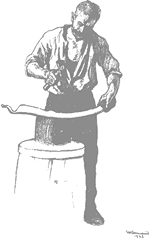About Us
My name is Elliot Fishbein and I am a scythe enthusiast.
I enjoy the grace and simplicity of human powered tools. They are direct and honest. You know the source of the power and its limits. There's no deception, it's your power not horsepower. The pace of work permits skillful control and subtle corrections. The tool does not have a mind of its own and can't get away from you. The relationship between you and the scythe is like a musician to an instrument. Together you can play many tunes but it's all music.
We live in rural coastal Maine and are organic market gardeners. Here at Shore Road Farm we're always looking for tools that lighten the burden of labor. Tools like these become good friends, they work with you in the doing of a job and are gratifying to use. The European scythe, refined through centuries of use, is efficient and minimal. It is a tool perfectly suited to its task. This competence makes the scythe a pleasure and a friend.
A general overview
There are basically two styles of scythes, the European and the American. I prefer the European scythe.
The European pattern (Austrian style) is an example of industrial metalworking art. The blades are hand crafted using a traditional hammering process that produces a light, and tensioned structure. Strength is derived from the thin curved skin of the blade not from excess metal. The human controlled nature of the work leaves each piece with unique character and the skill of the artisan is demonstrated in the final passes of the hammer as they form a pattern on the metal surface. This type of blade is fitted to a light weight wooden snath. The handles are comfortably positioned permitting an upright stance and the blade is adjusted to skim parallel to the ground. 
Sharpening is a combination of hammering (peening) and honing with a whetstone. The cutting edge is drawn out thin using a cross peen hammer and a small anvil. This is done occasionally to restore the working edge. In the field the blade is frequently and quickly dressed with a water-soaked stone.
The American pattern scythe lacks the refinement of the European model. The blades are heavier and do not have the curves or tension of the European style. Mounted on a heavy bent-wood snath (also an American pattern) this scythe is hard to use and less efficient. These blades are sharpened on a grindstone.
Why use a scythe?
It's simply satisfying and fun.
Here's what appeals to me:
- This tool does such a good job it makes me smile.
- The scythe is powered by my own internal combustion. This renewable personal resource produces no fumes (OK, I admit to occasional fumes) or noise and requires no complex machinery.
- It starts and stops when I want it to. It amplifies my strength but is not more powerful than me.
- An opportunity to momentarily escape from the modern world.
- The choice of NOT cutting a flower in the grass. The stroke is infinitely adjustable and sensitive to changing terrain and conditions.
- Appreciation of the beauty and diversity of tall grass. Allow the grass and wildflowers to bloom and be amazed at the variety coming from that boring homogenous lawn.
- The rhythmic cutting motion does not have to be stressful. Its patterns can be dance-like and relaxing. There is therapy in this kind of mindful exercise. You are both entertained and rewarded by this labor. This is kinetic meditation.
- Demonstrating a commitment to environmental responsibility.
That's a lot from a simple tool.
